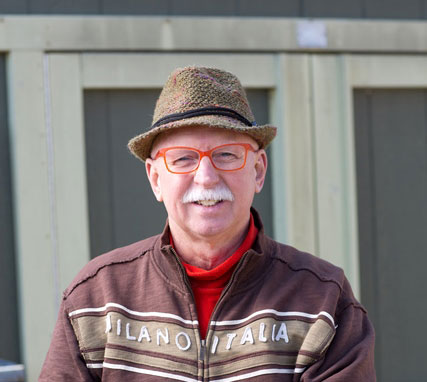I can use my shovel. I can mow the lawn. I can ride a bike.

Rick knew he needed a knee replacement. The active, fit 65-year-old had gone through rounds of anti-inflammatory and injection therapies to deaden the pain of the arthritic joint, and his orthopedic surgeon, John Schnell, told him that he would know when the timing was right.
It was the avid gardener’s shovel that ultimately delivered the message.
“I tried to push the shovel down with my right foot, and that night, I was dying,” Rick says. “I thought, I can’t dig anything ever again.”
A total knee replacement would eventually get this green thumb back to his shovel and his garden again.
Because Rick’s right knee had been under so much wear and tear, a total knee replacement was the best option, says Schnell. He adds that the word replacement is a bit of a misnomer. In actuality, it’s more of a resurfacing of the joint. Surgeons will remove a few centimeters of bone to make space in the knee for the synthetic materials that comprise the new joint.
“I always tell my patients that the replaced knee is never like your original knee, in terms of its capabilities and how it moves. But it’s pretty close.”
Rick commends Schnell for his bedside manner. Leading into the surgery, he says that Schnell, who had undergone a knee replacement himself, made him feel confident, speaking about his own experiences.
“He didn’t over-exaggerate it, but he also wasn’t nonchalant about it. He was very realistic about what it was going to be.”
Rick’s highly motivated spirit kicked in immediately after surgery. His speedy recovery is due in large part to his determination, Schnell says.
“Rick is a motivated guy and patients who are motivated are going to do well.”
Within hours, he was up and moving around on the new joint. As soon as he was able, he went to work on his rehabilitation, impressing his physical therapists by walking into his very first session. Rick emphasizes that from his experience, knee replacement patients must be active participants in their recoveries.
“You’re going to have to do the work after. If you’re not an active person, it’s going to be kind of a shock.”
According to Schnell, Rick’s prognosis is good. He’s cleared to do unlimited low impact biking, use an elliptical, walk, or hike.
“I do restrict my knee replacements form running and jumping, because the knee doesn’t hold up long term with that.”
Rick seems satisfied with that. He’s delighted to be walking and gardening again, pain free.
“This fall came, and I had a lot of bulbs I had to dig out, and I dug it all out myself without pain. I can use my shovel. I can mow the lawn. I can ride a bike.”
Meet Mako
Rick’s total knee replacement was done using Mako robotic arm assisted technology. The technology has been in use at RWJUH Hamilton since 2015 for hip and partial knee surgery, but total knee replacements are a newer approach following recent FDA approval. Mako combines guided navigation with robotic accuracy. Unlike with other types of robotic surgeries, the surgeon remains tableside, guiding the device. The surgery itself places less stress on the knee joint, resulting in less blood loss. The resulting incision can even be closed with surgical glue.